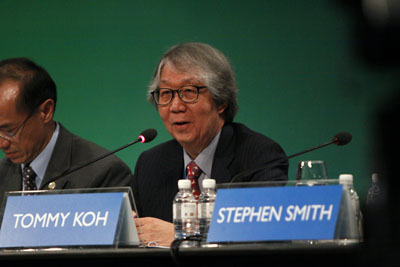I wish to make six points regarding Mr Hatoyama’s proposal:
First, I note that the Japanese Prime Minister does not intend to create a new institution, but to work with existing institutions. ASEAN shares this position.
The region already has enough institutions – including ASEAN+3 (ASEAN plus China, Japan and South Korea), the East Asia Summit (EAS), the Asia-Pacific Economic Cooperation (APEC) forum and the ASEAN Regional Forum. ASEAN +3 and the EAS are the two most relevant institutions for building the East Asian Community.
Second, Japan should continue to work closely with ASEAN and support the central role that ASEAN plays in the region’s institutional architecture.
All the major powers wish for ASEAN to continue to play the role of convener and facilitator. As Singapore’s Foreign Minister George Yeo noted recently, ASEAN is in the driver’s seat not because it is the best driver, but because it is acceptable to all the passengers.
Third, we should remain committed to three important principles animating our regional institutions: transparency, inclusiveness and equality.
Our regional institutions are open and transparent. They are inclusive. No legitimate stakeholder is excluded. They are based upon the principle of sovereign equality of states.
We should resist any attempt to separate the powerful from the less powerful and to create a hierarchical structure or a concert of the major and middle powers which would presumably ‘rule’ over the less powerful states of the region.
Fourth, I support Mr Hatoyama’s proposal to focus on building a multi-layered network of functional communities.
Let me mention some examples. We have the Chiang Mai Initiative, launched in 2000 by ASEAN +3 in the aftermath of the Asian financial crisis of 1997 to 1998, to create a standby mechanism for currency swaps in the event of currency turbulence. We should push ahead with proposals to conclude an ASEAN +3 free trade agreement, as well as a comprehensive economic partnership agreement for ASEAN +6 (ASEAN +3 plus India, Australia and New Zealand).
On the cultural front, EAS has endorsed the Nalanda University project. Located in Bihar, India, Nalanda was a great centre of learning, not just of Buddhism but also of mathematics and science. The revival of Nalanda University will connect our past to our present and future. It is a symbol of Asia’s cultural renaissance.
One other initiative deserving of Japan’s support is the ASEAN Connectivity Initiative. The idea is simple. In order to facilitate ASEAN’s economic integration, we need better connectivity among the 10 ASEAN countries – by road, rail, sea, air, etc. The Initiative also has an external dimension which aims to link ASEAN with all its dialogue partners in East Asia.
Fifth, we should build new areas of cooperation.
In his Singapore address, Mr Hatoyama mentioned several ideas. Let me recount three here:
He proposed that we work together to achieve a ‘green Asia‘ and to tackle climate change. He generously offered to make available to other Asian countries Japan’s energy-saving technologies, smart grid power systems, water purification technologies and other environmentally friendly technologies.
Another proposal is for the countries of Asia to work together for peace at sea. The oceans and seas are our precious global commons. We should all support the rule of law at sea. We should scrupulously abide by the United Nations Convention on the Law of the Sea.
Japan has played a leading role in helping the three littoral states of the straits of Malacca and Singapore to keep those straits safe and clean. We have successfully reduced the threat of piracy in South-east Asia.
Finally, I like very much Mr Hatoyama’s emphasis on the importance of people-to-people exchange. He is right when he said that the vision of an East Asian Community cannot be achieved without the support of the people. I fully support his two specific ideas of increasing youth exchanges between the countries of Asia and facilitating the exchange of university students by agreeing to accept the portability of academic credits earned by exchange students when abroad.
The East Asian Community should strive for inclusiveness. Instead of seeking to define the region along racial or geographical lines, the community should reflect the existing linkages within East Asia as well as across the Pacific. History has taught us that we should never again allow a rift to occur between the western and eastern rims of the Pacific.
For these reasons, we should regard India, Australia and New Zealand as part of the East Asia family. We should also consider how best to engage the United States and Russia within this family.
I support Prime Minister Hatoyama’s vision of building an East Asian Community. My advice is to use the existing institutions and not to create a new one. I urge Japan to continue to support the central role which ASEAN plays in the region’s architecture.
This article is based on Professor Koh’s speech at a symposium on ‘Building an East Asian Community’, hosted last month by the Japan Institute of International Affairs, and was originally published at the Straits Times on 7 April 2010.
Tommy Koh is Professor and Chairman of the Centre for International Law, National University of Singapore and Ambassador-At-Large for the Government of Singapore.

